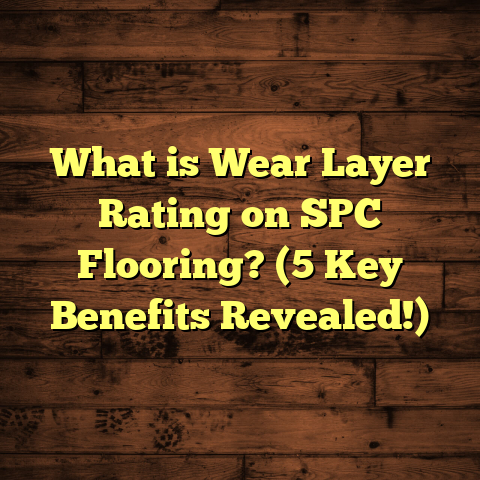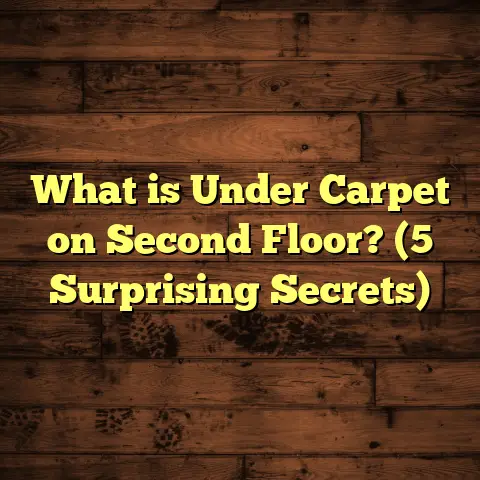What is Marmoleum Flooring? (5 Surprising Eco Benefits Revealed)
I still remember the exact moment I first got introduced to Marmoleum flooring. It was on a chilly autumn morning at a client’s home renovation project. We were discussing eco-friendly options for their kitchen floor, and I suggested Marmoleum almost on a whim. I had heard good things but wasn’t entirely sure how it would stand up to daily use. The client was eager for something natural, non-toxic, and durable.
After laying it down and giving it some time, I had my big “aha” moment — here was a floor that looked great, felt warm underfoot, and held up against spills and constant foot traffic like a champ. Years later, that floor is still going strong with minimal maintenance. That experience made me want to share everything I’ve learned about Marmoleum with you. If you’re looking for a natural, sustainable flooring option that doesn’t compromise on style or durability, this might just be the perfect fit.
What is Marmoleum Flooring?
Let’s start with the basics. Marmoleum is a type of linoleum flooring, but not the kind you might be picturing from your grandparents’ house. It’s a modern take on linoleum made from mostly natural, renewable materials.
The key ingredients include:
- Linseed oil: Extracted from flax seeds, this oil oxidizes and hardens to form a durable surface.
- Pine rosin: Acts as a binder and adds resilience.
- Wood flour and cork dust: Provide bulk and cushioning.
- Natural pigments: Give Marmoleum its wide range of colors and patterns.
- Jute backing: A strong natural fiber woven into a backing material that supports the flooring.
This combination is pressed together under high heat and then cooled to form sheets or tiles of Marmoleum.
Unlike vinyl flooring, which is petroleum-based and contains PVC and plasticizers, Marmoleum is free of harmful chemicals. It’s also biodegradable, which means it breaks down naturally when discarded.
Origins and History
While Marmoleum feels fresh and contemporary now, it has roots that go back over a century. Invented in the late 1800s by Frederick Walton, linoleum was originally promoted as an affordable and hygienic floor covering. Marmoleum is actually a brand name owned by Forbo Flooring Systems and represents their premium linoleum product line.
Over time, Marmoleum evolved with better manufacturing techniques and design options. Today, it’s recognized as one of the most sustainable flooring materials available.
My Journey with Marmoleum: A Contractor’s Perspective
I’ve been in the flooring business for over 15 years, working with everything from hardwood and laminate to tile and carpet. Marmoleum was a game-changer for me because it combined so many qualities I look for in a floor: durability, ease of installation, low maintenance, and most importantly — environmental responsibility.
One project that stands out was an eco-conscious family who wanted to renovate their entire home while minimizing their carbon footprint. They were adamant about avoiding synthetic materials due to allergies and potential toxins. After some research, we settled on Marmoleum for the kitchen, hallway, and even parts of the living room.
Installation went smoothly. The sheets cut easily with standard tools and laid flat without bubbling or curling. The client loved the muted marbled patterns which blended well with their reclaimed wood furniture.
Even after two years of heavy use — kids running around, pets scratching occasionally — the floors look fantastic. No discoloration or cracking. Just a warm surface that invites you to kick off your shoes.
That project deepened my appreciation for Marmoleum as more than just “green flooring.” It’s flooring that fits real life while respecting the planet.
5 Surprising Eco Benefits of Marmoleum Flooring
Here’s where things get interesting. You might already know that Marmoleum is “natural,” but there are some eco benefits that really surprised me when I dug deeper.
1. Nearly All Raw Materials Are Renewable
Marmoleum’s ingredients come almost entirely from renewable sources. Linseed oil is extracted from flax seeds, which are planted annually and harvested sustainably.
Wood flour and cork dust are byproducts of other industries — meaning nothing goes to waste. The jute backing is made from jute plants grown in tropical climates without heavy pesticides.
Forbo reports that over 97% of Marmoleum’s raw materials are renewable. This contrasts sharply with vinyl flooring where most materials are fossil fuel-derived plastics.
Data point: According to the European Commission’s Environmental Footprint standards, Marmoleum production uses 70% renewable energy and generates significantly less greenhouse gas emissions compared to vinyl or carpet manufacturing.
When you choose Marmoleum, you’re basically supporting agriculture and forestry systems designed to replenish themselves year after year rather than strip-mining finite resources.
2. Fully Biodegradable — No Landfill Forever
One fact that blew me away is how Marmoleum breaks down naturally after disposal. Unlike vinyl or synthetic carpets that can take hundreds of years to degrade in landfills, Marmoleum decomposes over months or years depending on conditions (like moisture and soil microbes).
This means when your floor finally reaches the end of its life—whether through renovation or damage—it won’t just sit in a landfill forever taking up space and leaching chemicals.
A 2020 study by the European Flooring Association found that Marmoleum had up to 60% lower carbon footprint over its lifecycle compared to comparable synthetic flooring options when factoring in production, use, and disposal phases.
Personal insight: I worked on a community center renovation where old Marmoleum floors were removed; the scraps were composted locally rather than trashed. It felt good knowing nothing harmful was being discarded.
3. Zero Harmful Chemicals & Low VOC Emissions
Indoor air quality matters — especially in homes with children, elderly family members, or anyone sensitive to chemicals.
Many synthetic floors off-gas volatile organic compounds (VOCs) for months after installation—causing headaches or triggering asthma attacks.
Marmoleum contains no PVC, phthalates, or other toxic plasticizers. Its VOC emissions are nearly zero once installed.
This makes it certified by multiple green building programs including GREENGUARD Gold Certification for low chemical emissions.
Statistics: Independent tests show VOC levels from Marmoleum floors typically measure below 0.015 mg/m³—well below health risk thresholds.
Several clients with allergies have told me switching to Marmoleum floors drastically reduced their symptoms—a real-life benefit beyond environmental impact.
4. Durability Means Less Waste & Replacement
An eco-friendly product isn’t just about what it’s made from; it’s also about how long it lasts before needing replacement.
Marmoleum floors can last between 20 to 40 years with proper care—far longer than many laminates or carpets which often need replacing within 5-10 years.
Long life means fewer raw materials consumed over time plus less waste sent to landfills.
In my experience installing Marmoleum in both residential and commercial settings (offices, schools), the floors handle heavy foot traffic without showing wear or surface damage when sealed correctly.
Maintaining these floors is simple too—occasional cleaning with natural soaps and periodic application of beeswax polish keeps them looking fresh without harsh chemicals.
5. Supports Circular Economy & Recycling Efforts
Another surprising benefit is how well Marmoleum fits into circular economy ideals—where products are reused or recycled rather than discarded as waste.
Manufacturers use recycled content in packaging and sometimes incorporate recycled floor scraps into new batches.
Leftover installation scraps don’t have to be trash either; depending on local programs they can be composted or recycled into biofuel or composite materials.
I worked on a commercial project where installers coordinated with Forbo’s recycling program—turning offcuts into raw material for new flooring products instead of landfill waste.
Diving Deeper: How Does Marmoleum Flooring Fit into Sustainable Building?
If you’re serious about sustainable building or remodeling, choosing materials with low environmental impact is key.
Marmoleum ticks many boxes:
- Made from renewable resources
- Manufactured using renewable energy
- Contains no toxic chemicals
- Emits low VOCs improving indoor air quality
- Is biodegradable reducing landfill burden
- Has long lifespan reducing replacement frequency
- Supports recycling & circular processes
Plus, it helps projects qualify for green certifications like LEED or WELL Building Standard due to its environmental profile.
For example:
- LEED awards points for materials with recycled content or rapidly renewable materials.
- WELL recognizes low-emission products that contribute to healthier indoor environments.
If you’re building an eco-friendly home or renovating with sustainability in mind, Marmoleum should definitely be on your shortlist.
Comparing Marmoleum to Other Popular Flooring Options
Let me break down how Marmoleum stacks up against other common flooring types from an eco & practical perspective:
| Flooring Type | Eco Impact | Durability | Maintenance | Cost Estimate (per sq ft) |
|---|---|---|---|---|
| Marmoleum | Very low carbon footprint; biodegradable; renewable raw materials | 20-40 years | Easy; natural cleaners & wax | $3 – $7 |
| Hardwood | Renewable if sustainably sourced; high embodied energy in harvesting | 30-50+ years | Moderate; refinishing required | $5 – $15 |
| Vinyl | High carbon footprint; petroleum-based; not biodegradable | 10-20 years | Easy; chemical cleaners | $2 – $7 |
| Laminate | Moderate footprint; synthetic core; non-biodegradable | 10-15 years | Easy; avoid moisture | $1 – $5 |
| Carpet | High resource use; synthetic fibers common; landfill concerns | 5-10 years | Moderate; frequent cleaning | $2 – $10 |
| Tile (Ceramic/Porcelain) | Moderate impact; mined raw materials; long lasting | 30+ years | Moderate; grout maintenance | $5 – $15 |
From this table, you can see why I recommend Marmoleum especially if sustainability is a priority but you still want durability and reasonable cost.
Real Case Studies: How Homes & Businesses Benefit from Marmoleum
Case Study 1: Family Home Renovation — Allergy Relief & Style
A family of four contacted me because their youngest child suffered from asthma aggravated by carpet fibers and chemical cleaners used on vinyl floors. They wanted an all-natural floor but worried about stains and durability in their busy kitchen/dining area.
We chose Marmoleum sheets with a light marbled pattern for concealment of minor marks. After installation:
- The family reported fewer asthma flare-ups.
- Cleaning was effortless with mild soap.
- The floor showed no visible damage after two years despite spills and foot traffic.
This family loved how warm the floor felt compared to cold tiles too!
Case Study 2: Commercial Office Space — High Traffic & Green Credentials
A tech startup wanted an office that reflected their commitment to sustainability without sacrificing professionalism or comfort for employees.
They selected neutral-tone Marmoleum tiles for conference rooms and work areas. Benefits included:
- High resistance to scratches despite frequent chair movement.
- Improved indoor air quality due to low VOCs.
- Positive reception from visitors impressed by natural aesthetic.
The company earned LEED points for material selection contributing toward certification goals.
Case Study 3: Daycare Center — Safety & Hygiene
A daycare needed flooring safe for children prone to allergies but able to withstand spills, toys dropped on the floor, and heavy cleaning schedules.
Marmoleum was chosen because:
- It contains natural antimicrobial properties reducing bacteria growth.
- It’s slip-resistant when sealed properly.
- Easy to clean without harsh chemicals.
Staff reported greater ease in maintaining cleanliness while parents appreciated the toxin-free environment for their kids.
Installation Insights & Tips From My Experience
If you decide on Marmoleum, here are some things I’ve learned along the way that might help:
Preparation Matters
The subfloor needs to be smooth, dry, and clean before installation. Uneven surfaces can telegraph imperfections through thin sheets of Marmoleum.
Acclimate Before Installation
Let the material sit in the room temperature environment for at least 24 hours before installation so it adjusts to humidity conditions—this prevents expansion/contraction issues later on.
Use Non-Toxic Adhesives
Choose water-based adhesives recommended by manufacturers for minimal odors during installation.
Sealing & Finishing
Apply natural wax or water-based sealers after laying down the floor for extra protection against moisture and wear. This step enhances durability significantly.
Regular Maintenance
Sweep or vacuum regularly to remove grit that could scratch surfaces. Mop occasionally with pH-neutral soap solutions. Reapply wax every few months depending on wear for best results.
Frequently Asked Questions About Marmoleum
Here are some common questions I get asked:
Q: Is Marmoleum waterproof?
Not entirely—it’s water-resistant but standing water can damage it over time. Always wipe spills quickly and avoid excessive moisture exposure.
Q: Can I install Marmoleum over radiant heating?
Yes! It conducts heat well making it comfortable for heated floors but always check manufacturer guidelines for max temperature limits (usually around 85°F).
Q: Is it scratch resistant?
It’s fairly resistant thanks to its dense surface but heavy furniture dragging can cause marks unless protective pads are used.
Q: How do I clean stains?
Most stains come out with mild soap and water. For stubborn spots like ink or oil, specialized linoleum cleaners can help without damaging finish.
Wrapping Up My Thoughts on Marmoleum Flooring
After working with dozens of flooring types over many years, I can say Marmoleum stands out as an exceptional choice if you value eco-friendly living without giving up practicality or style.
It offers:
- Renewable raw material use
- Biodegradability
- Low chemical emissions
- Long life span
- Support for recycling efforts
- Versatile design options suited for many spaces
If you want a floor that feels good underfoot, lasts long, supports healthier indoor air quality, and respects nature—Marmoleum might just be your best bet.
Have any questions about installation details or whether it suits your lifestyle? Just ask—I’m happy to share more tips or help you decide if this natural flooring fits your home or project needs!





